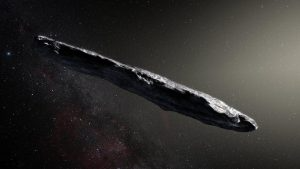Debunking Alien Theories, New Study Tries To Explain UH-Discovered ʻOumuamua
Mysteries have swirled around the origin of interstellar object ʻOumuamua since astronomers on Haleakalā first discovered it in 2017 with the University of Hawaiʻi Pan-STARRS1 (Panoramic Survey Telescope and Rapid Response System) telescope
 The latest theory published in Nature envisions ʻOumuamua as a water-rich comet traveling through the space between stars. Over time, ʻOumuamua was bombarded by radiation, which formed hydrogen inside the comet. As hydrogen gas released from the interstellar comet, it accelerated.
The latest theory published in Nature envisions ʻOumuamua as a water-rich comet traveling through the space between stars. Over time, ʻOumuamua was bombarded by radiation, which formed hydrogen inside the comet. As hydrogen gas released from the interstellar comet, it accelerated.
 This artist’s impression shows the first detected interstellar asteroid ʻOumuamua. (Credit: ESO/M. Kornmesser)
This artist’s impression shows the first detected interstellar asteroid ʻOumuamua. (Credit: ESO/M. Kornmesser)
The new study speculated how hydrogen came off ʻOumuamua, which researchers wouldn’t have been able to detect. When water ice sits in space, the cosmic radiation interacts with it and produces hydrogen. When the hydrogen escaped, it created the acceleration that researchers originally observed, explaining why ʻOumuamua was accelerating, and nobody saw gas.
However, this theory does not explain the elongated shape of ʻOumuamua.
“I don’t disbelieve it, but I don’t think it is necessary to explain ʻOumuamua,” said Institute for Astronomy Astronomer Karen Meech, who was the leader of the team that first characterized the object. “I think it could be just an ordinary comet. The reason people didn’t think it could be just an ordinary comet is because all of the observations we had couldn’t fit together in a nice model. But people forget that we only observed it in detail for a little over a week. I think we just didn’t have enough data to do a comprehensive model that would fit all of the observations, yet we are trying anyway.”
ʻOumuamua, originally an object from another star system, has come close enough to Earth for astronomers to study. Usually, observing objects from other star systems only provides astronomers with remote observations that do not provide many details.
“One thing that is very interesting is how much effort is going to try and explain this one. It is the first of its kind that has ever been detected, it was a UH discovery which makes it exciting,” said Meech. “The level of scientific interest that has come from all directions is fascinating.”
Alien hypothesis not following scientific process
Most researchers from the scientific community can find common ground on what ʻOumuamua is. However, a Harvard professor continues to speculate that the object could be designed by an extraterrestrial intelligent civilization.
“Almost all of the scientific community thinks that it is a leftover building block from the process of forming planets,” said Meech. “There is one person who seems to be pushing the alien hypothesis. He has gone out on a limb, and now I fear he can’t back down.”
“I would’ve been happy if he had said ‘what would it take us to consider the evidence that would be necessary for us to go down the path that this is alien technology?’ That would have been okay because that is part of the scientific process,” added Meech. “But he has just outright declared that it is. The problem with that is that it is teaching students not to follow the scientific process.”
UH at the forefront
PAN-STARRS1 is the world’s leading Near Earth Object discovery telescope and is superb at finding faint, distant comets. After finding ʻOumuamua, Meech believes that there are going to be more opportunities in the future.
“To find one without a comet tail must mean they are awfully abundant. I think UH will be at the forefront of following these things. All of the big telescopes around the world are going to go after the next one and we hope to be leading the pack here at UH.”
Publication: Bergner, J.B., Seligman, D.Z. Acceleration of 1I/‘Oumuamua from radiolytically produced H2 in H2O ice. Nature, (2023). DOI: 10.1038/s41586-022-05687-w
Original Story Source: University of Hawaii at Manoa

 Alerts Sign-up
Alerts Sign-up